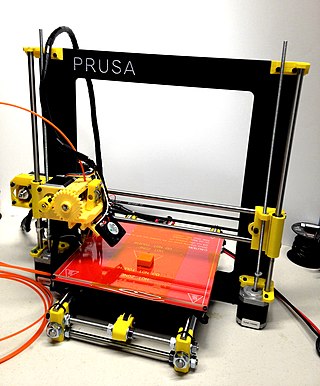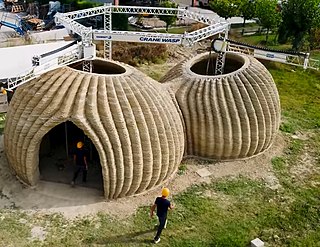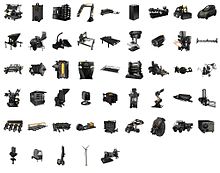
A tractor is an engineering vehicle specifically designed to deliver a high tractive effort at slow speeds, for the purposes of hauling a trailer or machinery such as that used in agriculture, mining or construction. Most commonly, the term is used to describe a farm vehicle that provides the power and traction to mechanize agricultural tasks, especially tillage, and now many more. Agricultural implements may be towed behind or mounted on the tractor, and the tractor may also provide a source of power if the implement is mechanised.

The open-design movement involves the development of physical products, machines and systems through use of publicly shared design information. This includes the making of both free and open-source software (FOSS) as well as open-source hardware. The process is generally facilitated by the Internet and often performed without monetary compensation. The goals and philosophy of the movement are identical to that of the open-source movement, but are implemented for the development of physical products rather than software. Open design is a form of co-creation, where the final product is designed by the users, rather than an external stakeholder such as a private company.
Marcin is a male given name or surname. It is the Polish equivalent of the English name Martin; the female version is Martyna.

A fab lab is a small-scale workshop offering (personal) digital fabrication.

Open-source hardware (OSH) consists of physical artifacts of technology designed and offered by the open-design movement. Both free and open-source software (FOSS) and open-source hardware are created by this open-source culture movement and apply a like concept to a variety of components. It is sometimes, thus, referred to as FOSH. The term usually means that information about the hardware is easily discerned so that others can make it – coupling it closely to the maker movement. Hardware design, in addition to the software that drives the hardware, are all released under free/libre terms. The original sharer gains feedback and potentially improvements on the design from the FOSH community. There is now significant evidence that such sharing can drive a high return on investment for the scientific community.

RepRap is a project to develop low-cost 3D printers that can print most of their own components. As open designs, all of the designs produced by the project are released under a free software license, the GNU General Public License.
The Shuttleworth Foundation was established in January 2001 by South African entrepreneur Mark Shuttleworth as an experiment with the purpose of providing funding for people engaged in social change. While there have been various iterations of the foundation, its structure and how it invests in social innovation, the current model employs a fellowship model where fellows are given funding commensurate with their experience to match a year's salary, allowing them to spend that year developing a particular idea. The Foundation announced that it is shutting itself down "by the beginning of 2024."
Notable issue tracking systems, including bug tracking systems, help desk and service desk issue tracking systems, as well as asset management systems, include the following. The comparison includes client-server application, distributed and hosted systems.

Clayton & Shuttleworth was an engineering company located at Stamp End Works, Lincoln, Lincolnshire, England. The company was established in 1842 when Nathaniel Clayton (1811–1890) formed a partnership with his brother-in-law, Joseph Shuttleworth (1819–83).

Agricultural machinery relates to the mechanical structures and devices used in farming or other agriculture. There are many types of such equipment, from hand tools and power tools to tractors and the countless kinds of farm implements that they tow or operate. Diverse arrays of equipment are used in both organic and nonorganic farming. Especially since the advent of mechanised agriculture, agricultural machinery is an indispensable part of how the world is fed. Agricultural machinery can be regarded as part of wider agricultural automation technologies, which includes the more advanced digital equipment and robotics. While agricultural robots have the potential to automate the three key steps involved in any agricultural operation, conventional motorized machinery is used principally to automate only the performing step where diagnosis and decision-making are conducted by humans based on observations and experience.
An open-source car is a car with open design: designed as open-source hardware, using open-source principles.
Construction 3D Printing (c3Dp) or 3D construction Printing (3DCP) refers to various technologies that use 3D printing as a core method to fabricate buildings or construction components. Alternative terms for this process include "additive construction." "3D Concrete" refers to concrete extrusion technologies whereas Autonomous Robotic Construction System (ARCS), large-scale additive manufacturing (LSAM), or freeform construction (FC) refer to other sub-groups.
Apache Allura is an open-source forge software for managing source code repositories, bug reports, discussions, wiki pages, blogs and more for any number of individual projects. Allura graduated from incubation with the Apache Software Foundation in March 2013.
eXtreme Manufacturing (XM) is an iterative and incremental framework for manufacturing improvement and new product development that was inspired by the software development methodology Scrum and the systematic waste-elimination (lean) production scheduling system Kanban(かんばん ).

Fused filament fabrication (FFF), also known as fused deposition modeling, or filament freeform fabrication, is a 3D printing process that uses a continuous filament of a thermoplastic material. Filament is fed from a large spool through a moving, heated printer extruder head, and is deposited on the growing work. The print head is moved under computer control to define the printed shape. Usually the head moves in two dimensions to deposit one horizontal plane, or layer, at a time; the work or the print head is then moved vertically by a small amount to begin a new layer. The speed of the extruder head may also be controlled to stop and start deposition and form an interrupted plane without stringing or dribbling between sections. "Fused filament fabrication" was coined by the members of the RepRap project to give an acronym (FFF) that would be legally unconstrained in its use.
Marcin Jakubowski founded Open Source Ecology (OSE) in 2003. Jakubowski is an advocate of open source hardware as a foundation for the open source economy – particularly distributed manufacturing, open source agriculture, and open source product development.

FarmBot is an open source precision agriculture CNC farming project consisting of a Cartesian coordinate robot farming machine, software and documentation including a farming data repository. The project aims to "Create an open and accessible technology aiding everyone to grow food and to grow food for everyone."

POC21 was an innovation camp that took place in Chateau de Millemont near Paris. It lasted for five weeks from August 15, 2015, until September 20, 2015. POC21 innovation camp hosted 100 makers, designers and innovators to develop a Proof of Concept of a truly sustainable society. The scope of such an innovation camp was unseen before. The 'accelerator' program developed 12 open source hardware projects from energy production and monitoring to living, mobility, communication and food production and preservation.

The Tecla house is a prototype 3D-printed eco residential building made out of clay. The first model was designed by the Italian architecture studio Mario Cucinella Architects (MCA) and engineered and built by Italian 3D printing specialists WASP by April 2021, becoming the world's first house 3D-printed entirely from a mixture made from mainly local earth and water. Its name is a portmanteau of "technology" and "clay" and that of one of Italo Calvino's Invisible Cities whose construction never ceases.















